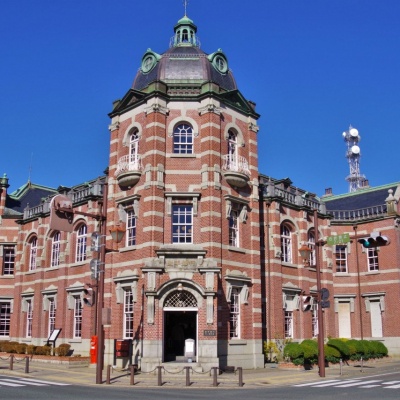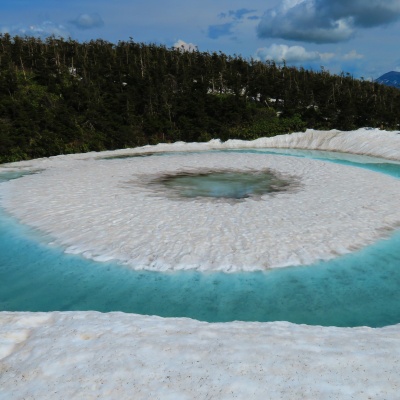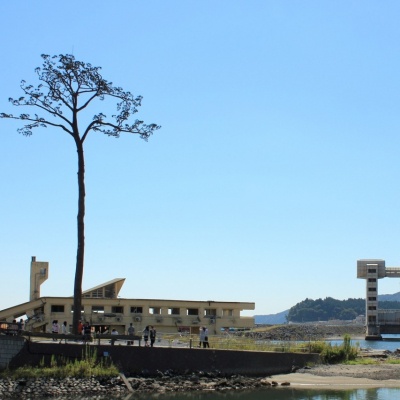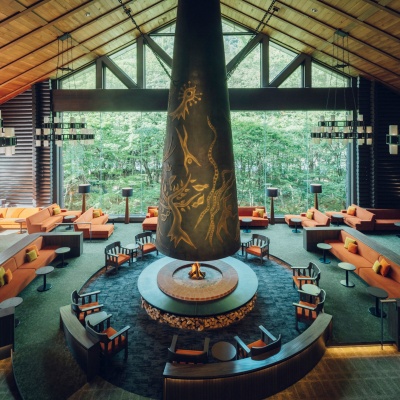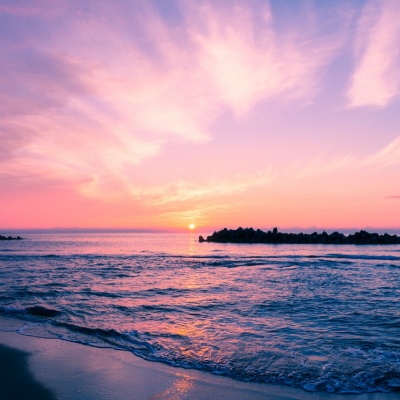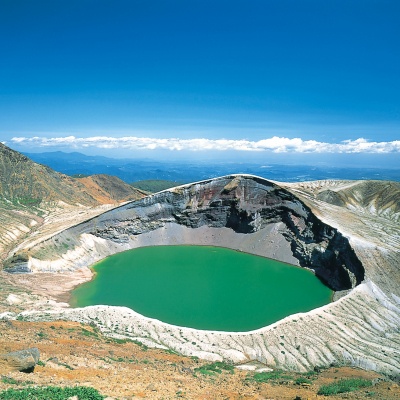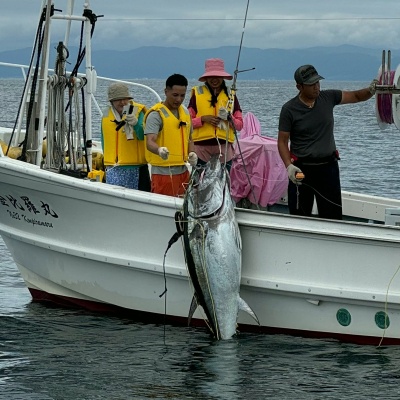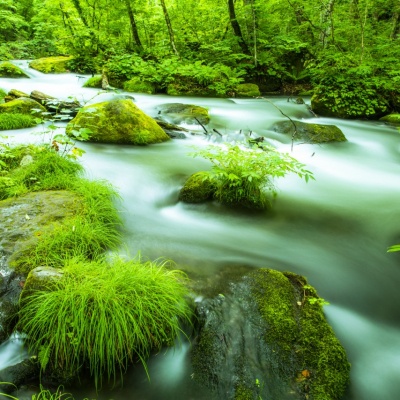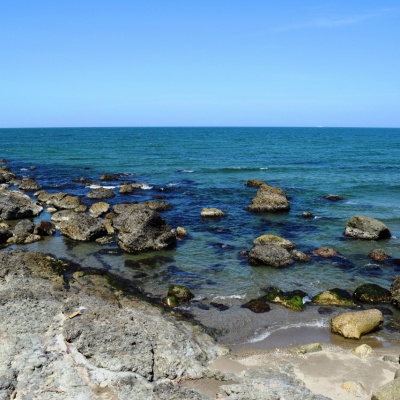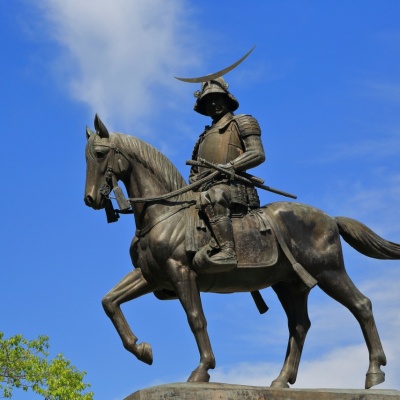Tour of Spectacular Tohoku Scenery Across All Four Seasons
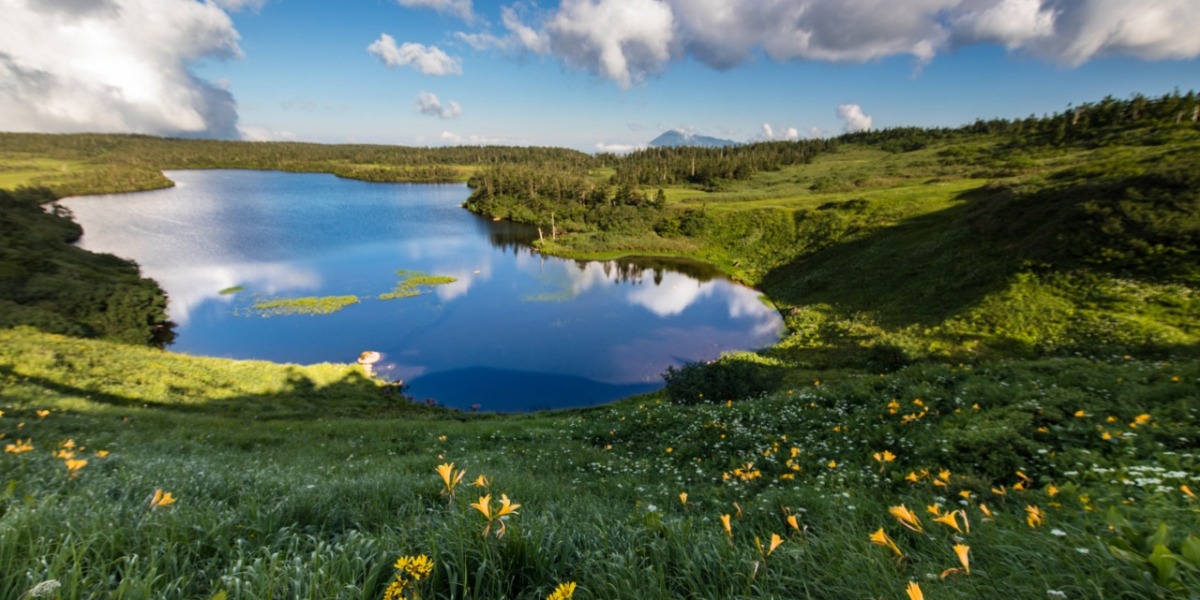
- Suggested Time : 3 days / 2 nights
- Transport Options : Drive
The Tohoku region is blessed with incredible natural beauty, including the mountains, ocean, mountain streams, and lakes. This route will take you to see Tohoku’s best views in each season: cherry blossoms, verdant greenery, autumn colors, and snowy landscapes. Please visit our website to see what each season offers.
(Morioka - Hachimantai - Towada/Oirase - Hachinohe - Asamushi - Hirosaki - Aomori)
START
Day1
Sendai-Hanamaki Airport, Morioka Station
Morioka Castle Ruins Park (Iwate Park)
The well-preserved stone walls are a must see. Enjoy year-round seasonal beauty in this castle ruins park!
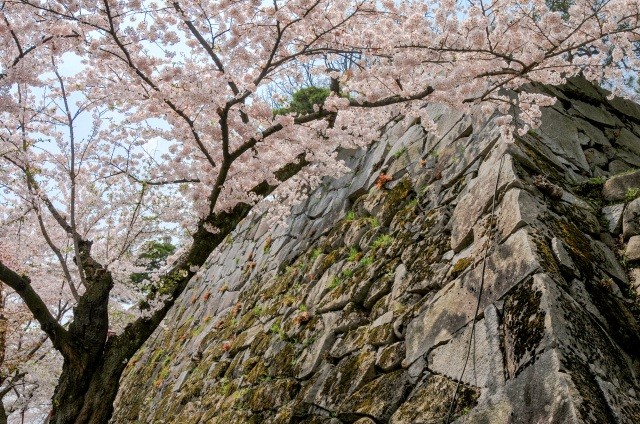
A 15-minute walk from Morioka station takes you to Morioka Castle, officially recognised as a national historic site and one of Japan’s top 100 castles.
When constructed in 1597 the castle was originally known as Kozukata Castle. It was the residence of the local feudal lords until 1874 when most of the buildings were demolished. Fortunately the stone walls remain in their original form and the castle grounds were preserved as a park in 1906.
Today the park is known as Morioka Castle Ruins Park and is a popular place for relaxation and recreation for locals. It is also recognised as one of Japan’s 100 best historical parks.
Many people come to the park during the springtime Sakura Festival. The view of cherry blossoms is enchanting when illuminated by paper lanterns at night. The park attracts visitors throughout the year with its seasonal beauty. Tsurugaike Pond is gracefully decorated with blooming wisteria trellises in May and hydrangeas in July. Scarlet maple leaves and vivid yellow gingko leaves are gorgeous in contrast with the castle’s stone walls in autumn. A large number of miniature snow huts create fascinating scenes when candlelit during Morioka Yukiakari Festival in winter.
The park is also home to monuments of some of the great names in literature including Takuboku Ishikawa, Kenji Miyazawa and Inazo Nitobe. Some of the works of each are inscribed on the monuments.
A thematic journey in the Tohoku region:Castles・SamuraiA thematic journey in the Tohoku region:Flowers
When constructed in 1597 the castle was originally known as Kozukata Castle. It was the residence of the local feudal lords until 1874 when most of the buildings were demolished. Fortunately the stone walls remain in their original form and the castle grounds were preserved as a park in 1906.
Today the park is known as Morioka Castle Ruins Park and is a popular place for relaxation and recreation for locals. It is also recognised as one of Japan’s 100 best historical parks.
Many people come to the park during the springtime Sakura Festival. The view of cherry blossoms is enchanting when illuminated by paper lanterns at night. The park attracts visitors throughout the year with its seasonal beauty. Tsurugaike Pond is gracefully decorated with blooming wisteria trellises in May and hydrangeas in July. Scarlet maple leaves and vivid yellow gingko leaves are gorgeous in contrast with the castle’s stone walls in autumn. A large number of miniature snow huts create fascinating scenes when candlelit during Morioka Yukiakari Festival in winter.
The park is also home to monuments of some of the great names in literature including Takuboku Ishikawa, Kenji Miyazawa and Inazo Nitobe. Some of the works of each are inscribed on the monuments.
A thematic journey in the Tohoku region:Castles・SamuraiA thematic journey in the Tohoku region:Flowers
Iwa cast iron equipment
Visitors can observe the manufacturing process of Nambu tetsubin, a traditional handicraft. Enjoy shopping at our well-stocked store.
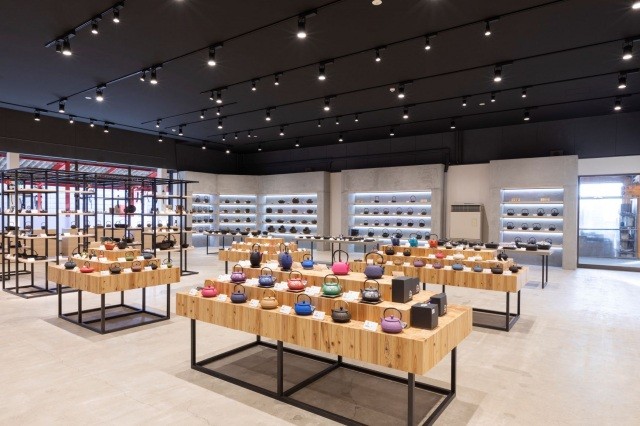
A theme park-type factory where visitors can see the craftsmanship of potters up close.Don't miss the ironware gallery, which boasts the largest selection of ironware in the prefecture.Nambu ironware is produced through many processes and human hands.The Nambu Tekki Gallery is a facility where visitors can see the manufacturing process of ironware up close.After admiring the dynamic and delicate world of manufacturing, such as casting and lacquer coloringAfter admiring the dynamic and delicate world of manufacturing, such as casting and lacquer coloring, visitors can visit the exhibition gallery, which boasts the largest selection of ironware in the prefecture.The staff, who are well versed in the manufacturing process and usage of ironware, will be happy to assist you with any questions you may have about ironware.Based on a tradition of over 400 years, new forms are being created every day.Come and experience the past, present, and future of Nambu ironware.
Hachimantai Dragon Eye (Kagami-Numa Lake)
Hachimantai Dragon Eye, a natural phenomenon that appears in a lake
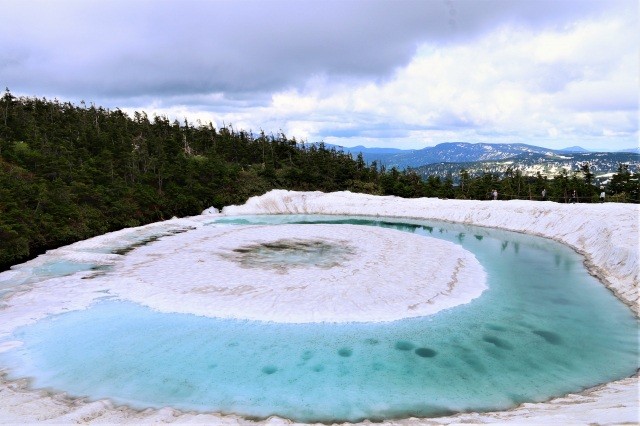
The Hachimantai Dragon Eye is a mysterious sight caused by a natural phenomenon of Kagami-Numa Lake, located near the summit of Mt. Hachimantai from late May to early June. The snow falls and piles up over the lake during winter. When the spring comes and it starts to thaw, the snow in the middle creates a ring. Then the sunlight and the color of the sky shines on it, creating the Dragon Eye. Near Kagami-Numa Lake is the emerald-green Megane-Numa Lake, which has recently been dubbed the “Tears of Dragon” and is popular among tourists along with the Dragon Eye. The area around Kagami-Numa Lake, where you can easily take a stroll while straddling the border between prefectures, has many craters created by steam explosions, and you can see many swamps such as the Hachiman-Numa Lake and the Gama-Numa Lake, whose water accumulates in these craters. The view from the observatory is also recommended. Be sure to enjoy the vast panorama of nature when you visit.
After seeing the dragon eye, stop by some nearby places to eat and enjoy beautiful seasonal views.
The information center of Hachimantai Dragon Eye
A thematic journey in the Tohoku region:Snowmelt
After seeing the dragon eye, stop by some nearby places to eat and enjoy beautiful seasonal views.
The information center of Hachimantai Dragon Eye
A thematic journey in the Tohoku region:Snowmelt
Kazuno Kanko Furusato Kan An-toraa
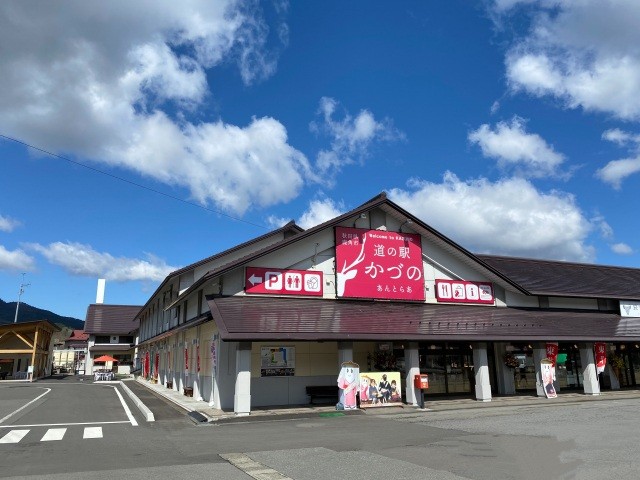
This roadside station is located along Route 282 connecting Lake Towada and Hachimantai.The "Festival Exhibition Hall" exhibits the gorgeous stalls actually used in the "Hanawa Matsuri no Yatai Event (Hanawa-bayashi)," which has been registered as a UNESCO Intangible Cultural Heritage site. The "Festival Exhibition Hall" exhibits the gorgeous stalls actually used at the "Kazuno" festival.
Oyu Stone Circle Museum (Kazuno, Akita Prefecture)
Travel back in time to the Jomon Era! Akita Stone Circle
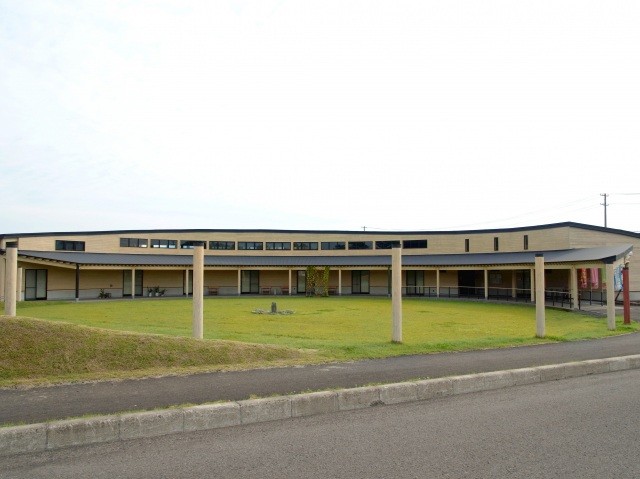
Visitors can learn about the Oyu Stone Circle through exhibits of earthenware excavated from the Oyu Stone Circle, a site dating back to the late Jomon Period (approximately 4,000 years ago). Visitors can also try their hand at making earthenware and pendants at the hands-on workshop.
Towada Oyu Onsen
The southern entryway to tourism in Towada
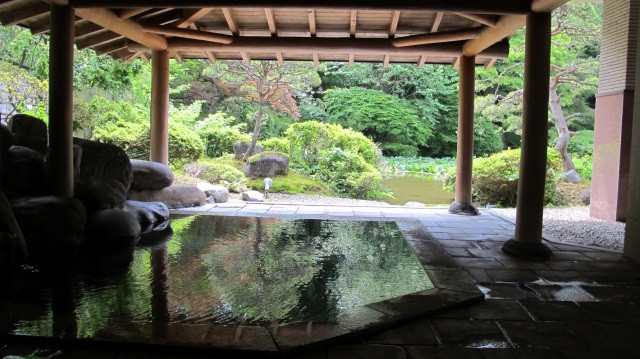
Located south of Lake Towada, Oyu Onsen is a hot springs area that naturally sprang forth along the Oyu River 800 years ago. It is an optimal area for tourism that includes Lake Towada. It has traditional hot springs that are not separated by gender, and the stinging hot water is said to be effective for recovery from weariness and against poor circulation.
The Oyu Bon Odori, the Oyu Onsen Summer Festival that includes a fireworks display, and the Oyu Odaiko Matsuri with over 50 drumming groups are held as festivals to enjoy the short summers in northern Japan. In winter, in addition to games such as treasure hunting in the snow, playing tug of war, and going “hip skiing,” the Oyu Onsen Winter Festival is held to enjoy drinking sake and other activities in Kamakura snow huts that are unique to the snow country of northern Japan.
A thematic journey in the Tohoku region:Hot springs
The Oyu Bon Odori, the Oyu Onsen Summer Festival that includes a fireworks display, and the Oyu Odaiko Matsuri with over 50 drumming groups are held as festivals to enjoy the short summers in northern Japan. In winter, in addition to games such as treasure hunting in the snow, playing tug of war, and going “hip skiing,” the Oyu Onsen Winter Festival is held to enjoy drinking sake and other activities in Kamakura snow huts that are unique to the snow country of northern Japan.
A thematic journey in the Tohoku region:Hot springs
Day2
Oirase Mountain Stream
With two stars in the Michelin Green Guide, this pristine stream is one of the most popular scenic locations in Tohoku
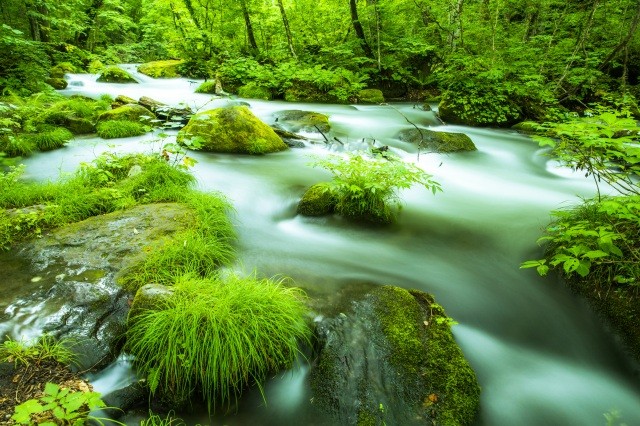
Oirase Mountain Stream is one of the most popular attractions in Tohoku and has been awarded two stars in the Michelin Green Guide. The stream stretching for 14km is home to boundless scenic beauty. The journey between viewing highlights can be made by car or bus however walking the route is particularly recommended in order to enjoy this spectacle to its fullest, the extra time and effort are highly rewarded! While walking through the natural green tunnels of the trail, visitors can appreciate the beauty of the vibrant mosses and foliage, breathe in the forest air, and be dazzled by the dance of the sunshine filtering through the overhead foliage on the sparkling water surface.
Photography enthusiasts in particular should walk from the lower to the upper stream to find the ideal vantage points of the natural light shining on the stream and surrounding foliage. The trail is an easy walk without any challenging climbs. The four-hour full trekking route from the pleasure boat pier of Lake Towada (Nenokuchi bus stop) to Yakeyama bus stop close to the Oirase Stream Museum is as follows:
Nenokuchi - (20min) - Choshi Otaki - (50min) - Kumoi no Nagare - (30min) - Kumoi no Taki - (30m) - Makado Iwa - (15min) – Ishigedo - (70min) - Yakeyama
The best time to enjoy the area’s verdant greens is from mid-May to mid-June. Gorgeous autumn leaves are at their best from mid to late October. Journey times may be slower due to traffic congestion during these peak seasons. Beat the crowd by starting your trek in the early morning and you will also have the chance to see the fantastic morning dews sparkling in the sunshine filtering through the foliage.
Photography enthusiasts in particular should walk from the lower to the upper stream to find the ideal vantage points of the natural light shining on the stream and surrounding foliage. The trail is an easy walk without any challenging climbs. The four-hour full trekking route from the pleasure boat pier of Lake Towada (Nenokuchi bus stop) to Yakeyama bus stop close to the Oirase Stream Museum is as follows:
Nenokuchi - (20min) - Choshi Otaki - (50min) - Kumoi no Nagare - (30min) - Kumoi no Taki - (30m) - Makado Iwa - (15min) – Ishigedo - (70min) - Yakeyama
The best time to enjoy the area’s verdant greens is from mid-May to mid-June. Gorgeous autumn leaves are at their best from mid to late October. Journey times may be slower due to traffic congestion during these peak seasons. Beat the crowd by starting your trek in the early morning and you will also have the chance to see the fantastic morning dews sparkling in the sunshine filtering through the foliage.
Towada Art Center
Public art everywhere! The entire street is an open-air museum
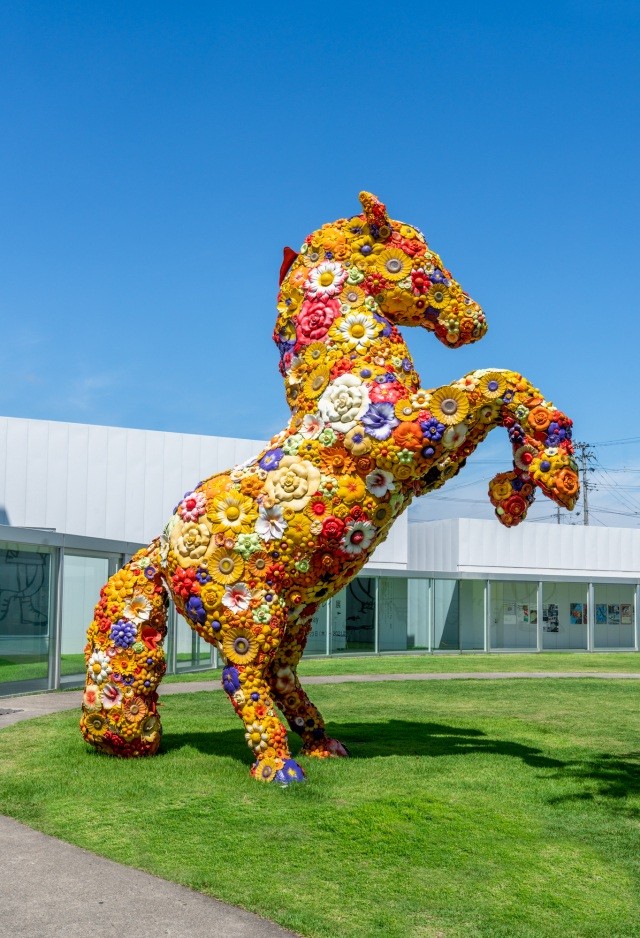
Arts Towada is a project based on the concept of developing the outside space along Kanchogai Avenue as a museum by putting a variety of art work on display. Kanchogai is a main road in the city and is dotted with fanciful public art.
As part of this art project, the museum's exhibition spaces have large glass openings that create a sense that the artworks are exhibited for the city outside as well. Permanent works of Japanese and foreign artists who are active in the field of contemporary art are located not only in the exhibition rooms of the museum but also in various places such as courtyards, rooftops, and staircases.
As part of this art project, the museum's exhibition spaces have large glass openings that create a sense that the artworks are exhibited for the city outside as well. Permanent works of Japanese and foreign artists who are active in the field of contemporary art are located not only in the exhibition rooms of the museum but also in various places such as courtyards, rooftops, and staircases.
Michinoku Shiokaze Trail Hachinohe City section
Michinoku Shiokaze Trail Hachinohe City section
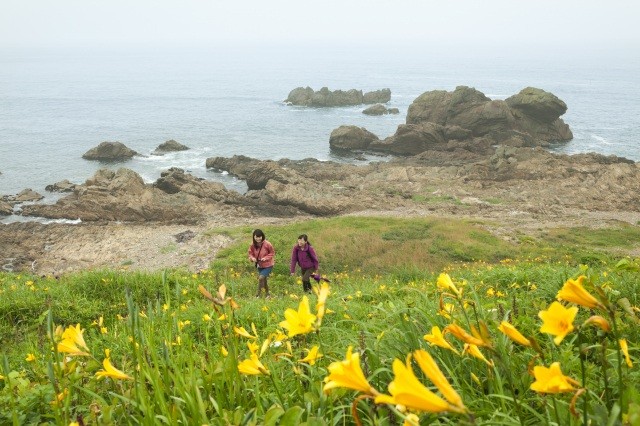
Passing along the shores of flowers, the trail takes you through a thousand different types of coastal scenery.The Michinoku Shiokaze Trail is a long trail that connects the 1,000-km Pacific Ocean coast from Hachinohe City, Aomori Prefecture to Soma City, Fukushima Prefecture.Its greatest attraction is the abundance of spots where visitors can experience the dynamic seascape.Along the route, there are the most beautiful cliffs in Japan, the unique scenery of the Rias coast, the world's three major fishing grounds rich in bounty, people's lives, culture and history, natural threats, and inherited food culture, and you can also enjoy the human interaction that is created while walking along the trail.As you continue through the overwhelming beauty of nature, swaying in the sea breeze, you will experience an unforgettable sensation.
≪Hachinohe City RouteThis is a trail course that takes you to the Tanezaki Coast, which is said to be one of the most scenic treasures in the Sanriku Fukko National Park.The coastal scenery, from rugged reefs to white sand and green pines, is impressive and changes as you walk.The sea breeze that shakes the wildflowers invites you to follow the gentle path, and your day begins as if you are encountering a lifetime's worth of beauty.
*Day trip model course Total distance: 11.3 km / Time required: approx. 4 hoursSame Station (JR Hachinohe Station) → Kabura-shima (Kabura-shima Shrine) → Ashimozaki Observatory/Horonbairu → Nakasuga → Osuga Beach → Yodo no Matsubara → Tanezashi natural grassland → Tanezashi Coast Information Center → Takaiwa Observatory → Okuki Station (JR Hachinohe Line)
*This information is current as of February 29, 2020.
≪Hachinohe City RouteThis is a trail course that takes you to the Tanezaki Coast, which is said to be one of the most scenic treasures in the Sanriku Fukko National Park.The coastal scenery, from rugged reefs to white sand and green pines, is impressive and changes as you walk.The sea breeze that shakes the wildflowers invites you to follow the gentle path, and your day begins as if you are encountering a lifetime's worth of beauty.
*Day trip model course Total distance: 11.3 km / Time required: approx. 4 hoursSame Station (JR Hachinohe Station) → Kabura-shima (Kabura-shima Shrine) → Ashimozaki Observatory/Horonbairu → Nakasuga → Osuga Beach → Yodo no Matsubara → Tanezashi natural grassland → Tanezashi Coast Information Center → Takaiwa Observatory → Okuki Station (JR Hachinohe Line)
*This information is current as of February 29, 2020.
Asamushi Onsen
Enjoy stunning sunset views at this hot spring resort on Mutsu Bay!
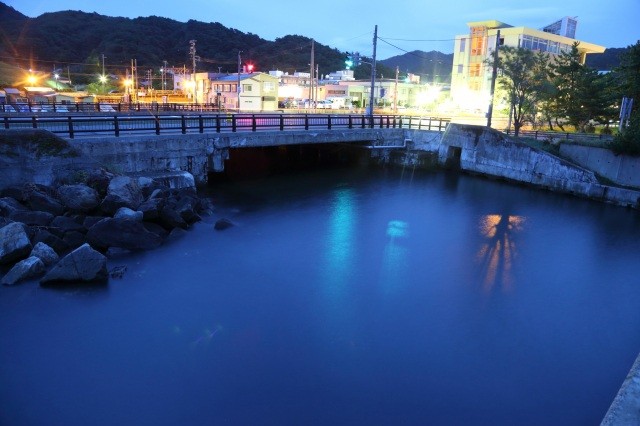
The scenic local “Aoimori Railway” line connects Aomori and the hot spring town of Asamushi Onsen. The free foot bath outside Asamushi Onsen station welcomes visitors with an exhilarating introduction to their Onsen experience. The Onsen town consists of two areas: the east side is a traditional hot spring town while the west side is a beach resort facing the sea.
With its narrow alleys lined with traditional hot spring inns and eateries, the eastern part of town displays the unchanged scenery of the old hot spring town. Here visitors can poach their own eggs in the hot spring waters at the “Onsen egg place” and the nearby drinking fountain is said to be beneficial for digestion. Other attractions on the east side are Asamushi Onsen Forest Park, recognised as one of Japan’s best 100 forest bathing locations and Asamushi Aquarium known for its popular dolphin performances.
Ocean lovers can enjoy bathing, windsurfing, yachting and fishing at the artificial sandy beach “Sunset Beach Asamushi” on the west side of town. The nearby Michi-no-Eki “Yusa Asamushi” is a roadside station offering a large hot spring bath with a panoramic view of Mutsu Bay. The luxury hotels lined along the Mutsu Bay coast offer popular modern hot spring resort experiences, the perfect place to enjoy a spectacular sunset view!
The clear hot spring water is pure, odourless, smooth to touch and moisturising on the skin. Along with promoting beautiful skin, the water is said to be beneficial for neuralgia, rheumatism, backache and a range of other ailments.
With its narrow alleys lined with traditional hot spring inns and eateries, the eastern part of town displays the unchanged scenery of the old hot spring town. Here visitors can poach their own eggs in the hot spring waters at the “Onsen egg place” and the nearby drinking fountain is said to be beneficial for digestion. Other attractions on the east side are Asamushi Onsen Forest Park, recognised as one of Japan’s best 100 forest bathing locations and Asamushi Aquarium known for its popular dolphin performances.
Ocean lovers can enjoy bathing, windsurfing, yachting and fishing at the artificial sandy beach “Sunset Beach Asamushi” on the west side of town. The nearby Michi-no-Eki “Yusa Asamushi” is a roadside station offering a large hot spring bath with a panoramic view of Mutsu Bay. The luxury hotels lined along the Mutsu Bay coast offer popular modern hot spring resort experiences, the perfect place to enjoy a spectacular sunset view!
The clear hot spring water is pure, odourless, smooth to touch and moisturising on the skin. Along with promoting beautiful skin, the water is said to be beneficial for neuralgia, rheumatism, backache and a range of other ailments.
Day3
Hirosaki Park (Hirosaki Castle Ruins)
Enjoy Hirosaki Castle and the beauty of the four seasons
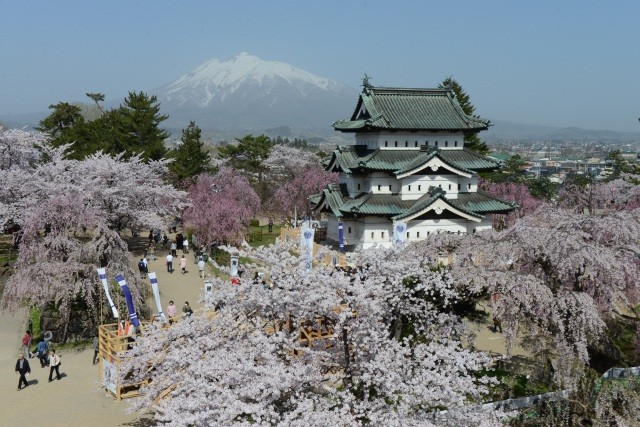
Hirosaki Castle was constructed back in 1611. The castle and the surrounding park opened as Hirosaki Park in May 1895 and has been enjoyed by many locals and visitors ever since.
The castle keep, five castle gates, and three corner turrets that have remained from the Edo period (1603-1867) are designated as National Important Cultural Properties.
Hirosaki Park is home to approximately 2,600 cherry trees of 52 varieties, making it one of the "Three Best Cherry Blossom Viewing Spots in Japan. There are many highlights, such as somei-yoshino, the oldest cherry tree in Hirosaki Park that is 140 years old, the illuminated yozakura (cherry blossoms at night), and "hanaikada," or flower rafts of cherry petals that cover the entire moat. The Hirosaki Cherry Blossom Festival, held every year from late April to early May, attracts many people from within and outside of the prefecture.
Currently, Hirosaki Castle's keep is being moved to the inner side of the castle's main citadel for repairs to the stonewalls, and for this limited time only, visitors can enjoy taking pictures of the keep and the cherry blossoms together with Mt. Iwaki.
In autumn, about 1,000 maple trees and 2,600 cherry trees turn brilliant colors, and chrysanthemum decorations and floral art adorn the site in the Hirosaki Castle Chrysanthemum and Autumn Leaves Festival. In winter, about 150 snow lanterns and snow statues handmade by citizens and about 300 miniature kamakura (Japanese igloos) lit with lights create a fantastic world in the Hirosaki Castle Snow Lantern Festival, offering beautiful seasonal scenes.
The castle keep, five castle gates, and three corner turrets that have remained from the Edo period (1603-1867) are designated as National Important Cultural Properties.
Hirosaki Park is home to approximately 2,600 cherry trees of 52 varieties, making it one of the "Three Best Cherry Blossom Viewing Spots in Japan. There are many highlights, such as somei-yoshino, the oldest cherry tree in Hirosaki Park that is 140 years old, the illuminated yozakura (cherry blossoms at night), and "hanaikada," or flower rafts of cherry petals that cover the entire moat. The Hirosaki Cherry Blossom Festival, held every year from late April to early May, attracts many people from within and outside of the prefecture.
Currently, Hirosaki Castle's keep is being moved to the inner side of the castle's main citadel for repairs to the stonewalls, and for this limited time only, visitors can enjoy taking pictures of the keep and the cherry blossoms together with Mt. Iwaki.
In autumn, about 1,000 maple trees and 2,600 cherry trees turn brilliant colors, and chrysanthemum decorations and floral art adorn the site in the Hirosaki Castle Chrysanthemum and Autumn Leaves Festival. In winter, about 150 snow lanterns and snow statues handmade by citizens and about 300 miniature kamakura (Japanese igloos) lit with lights create a fantastic world in the Hirosaki Castle Snow Lantern Festival, offering beautiful seasonal scenes.
Hirosaki Museum of Contemporary Art
A contemporary art museum in a renovated brick warehouse with 100 years of history
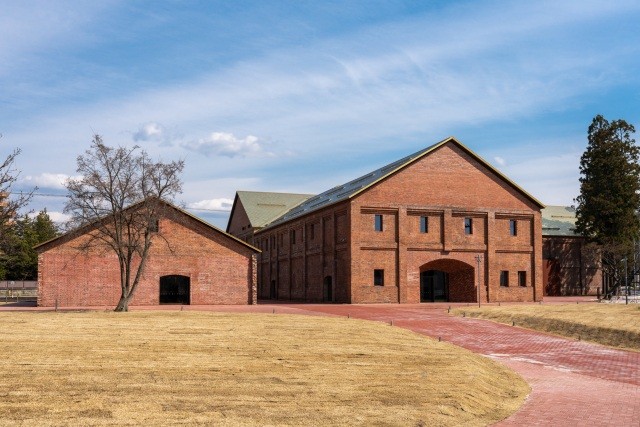
The brick warehouse that houses the Hirosaki Museum of Contemporary Art was built about 100 years ago as a brewery, and was also the first factory in postwar Japan to produce hard cider on a large scale. Before it was turned into an art museum, three exhibitions were held in the warehouse in 2002, 2005 and 2006 by Yoshitomo Nara, a contemporary artist from Hirosaki City. At the entrance of the museum now, you will be greeted by Nara’s “A to Z Memorial Dog,” which was donated as a token of gratitude to the volunteers who participated in the three exhibitions. The renovation turning the warehouse into a museum was designed by the energetic young architect Tsuyoshi Tane, who focused on three key points. 1. “Succession of memories” The building was reinforced against earthquakes while retaining as much of the existing brickwork and other elements as possible. 2. “Hirosaki-zumi stacked brick technique” The beautiful brick arch at the entrance, which provides a somehow warm feeling, were newly stacked for the museum in a technique named “Hirosaki-zumi,” as opposed to the existing English-style bricks. 3. “Cider gold hishibuki roof” Each roof of the museum is made from titanium, and the color changes depending on the way the light hits, yielding a variety of appearances. The exhibitions consist of three programs per year. Through contemporary art, the museum aims to be a creative hub (cultural hub) that connects the region to the world, exposes visitors to diverse visions and rich sensibilities, and inspires new creativity that connects the past to the present and the future. Enjoy spending a great time at the newly reborn Hirosaki Museum of Contemporary Art while experiencing the history and culture of Hirosaki.
Tour of Western-style architecture
Let's go see Western-style architecture of the Meiji period!
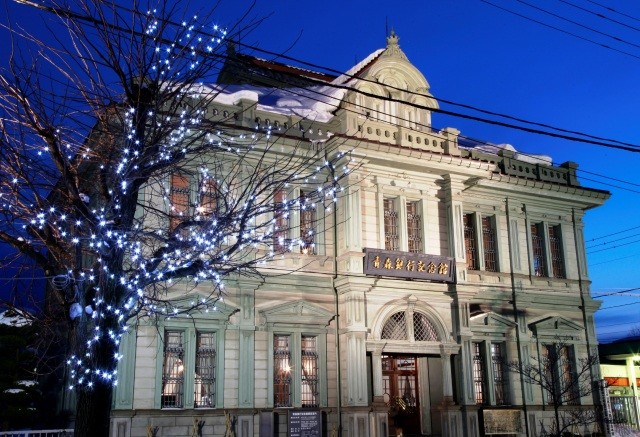
(1) Former 59th Bank Head Office Main Building (Aomori Bank Memorial Hall)Established in 1879, it was the first national bank in the prefecture and the 59th in Japan. It is a Renaissance-style Western-style building with a decorative tower at the top that also serves as an observatory, and at the top of the tower is a sorin, as seen in Indian temples. It is designated as a National Important Cultural Property.
(2) Former Touoku Gijuku Foreign Teachers' BuildingTooku Gijuku was the first private school opened in the prefecture in 1872, and this Foreign Missionaries' House was built for the foreign missionaries invited to the school. The chimneys and bay windows are tasteful, and the interior recreates life in those days. A coffee shop is open on the first floor of the building, where visitors can enjoy coffee and other beverages while looking through the windows at the miniature structures within Otemon Square.
(3) Former Hirosaki City LibraryBuilt in 1906 to commemorate the victory over Russia in the Russo-Japanese War, it was used as the municipal library until 1931. It is a three-story Renaissance-style wooden and mortar building with octagonal twin towers.
(2) Former Touoku Gijuku Foreign Teachers' BuildingTooku Gijuku was the first private school opened in the prefecture in 1872, and this Foreign Missionaries' House was built for the foreign missionaries invited to the school. The chimneys and bay windows are tasteful, and the interior recreates life in those days. A coffee shop is open on the first floor of the building, where visitors can enjoy coffee and other beverages while looking through the windows at the miniature structures within Otemon Square.
(3) Former Hirosaki City LibraryBuilt in 1906 to commemorate the victory over Russia in the Russo-Japanese War, it was used as the municipal library until 1931. It is a three-story Renaissance-style wooden and mortar building with octagonal twin towers.
Taste French cuisine in Hirosaki, the city of French cuisine
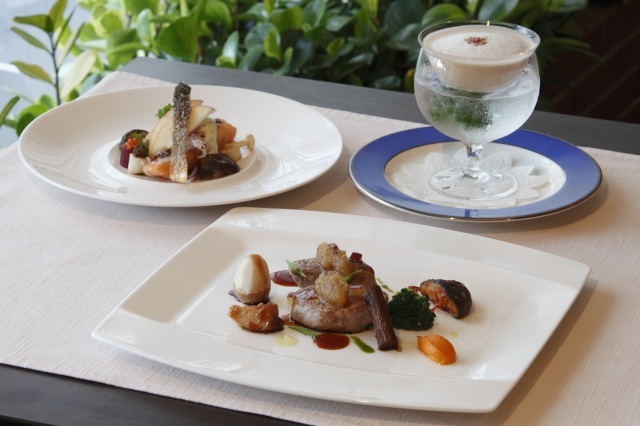
Hirosaki is said to have the largest number of French restaurants in Japan by population. Hirosaki is a very retro and charming city, with many classic Western-style buildings that have been actively introduced to Western culture since the Meiji period. Hirosaki, with its mix of different cultures, has nurtured excellent chefs under the influence of Western culture, and is famous for its unique French cuisine, a fusion of Aomori's proud ingredients and French cuisine.
Tachineputa no Yakata (Tachineputa Museum)
Meet Tachineputa standing 23 meters tall!
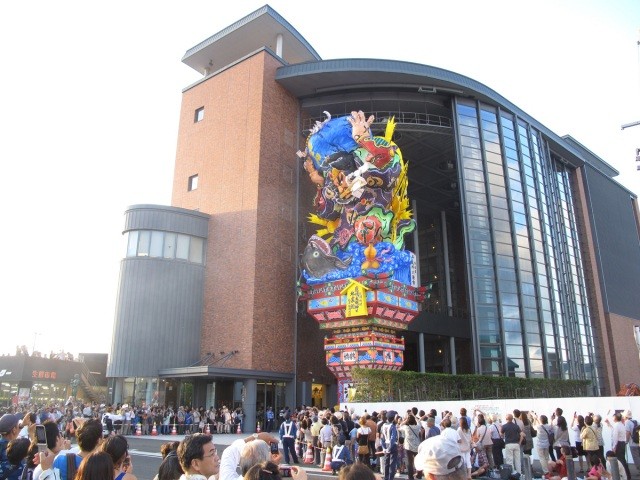
The Goshogawara Tachineputa Festival is one of the three major Aomori Neputa festivals, alongside with the Aomori Nebuta Festival and Hirosaki Neputa Festival. Its appeal lies in the magnificent parade of floats, with the tallest towering more than 20 meters high.
The Tachineputa no Yakata (Tachineputa Museum) is a facility where visitors can admire the power and impact of the Tachineputa. One will undoubtedly be overwhelmed by the Tachineputa that reaches heights equivalent to a four-story building. The exhibition space is a spacious atrium with an open structure extending from the first to the fourth floor, while the area around the Tachineputa is sloped to allow visitors to observe the display from different angles.
Visitors can also watch films of the festival, as well as watch demonstrations and experience playing taiko drums and traditional music accompaniment. It is an impressive facility that is definitely worth a visit.
A thematic journey in the Tohoku region:Festivals
The Tachineputa no Yakata (Tachineputa Museum) is a facility where visitors can admire the power and impact of the Tachineputa. One will undoubtedly be overwhelmed by the Tachineputa that reaches heights equivalent to a four-story building. The exhibition space is a spacious atrium with an open structure extending from the first to the fourth floor, while the area around the Tachineputa is sloped to allow visitors to observe the display from different angles.
Visitors can also watch films of the festival, as well as watch demonstrations and experience playing taiko drums and traditional music accompaniment. It is an impressive facility that is definitely worth a visit.
A thematic journey in the Tohoku region:Festivals
Aomori Museum of Art
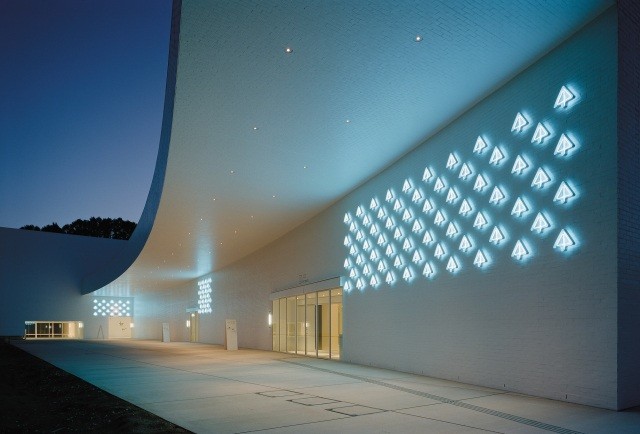
Inspired by the excavation site of the Sannai-Maruyama Ruins, the building was designed by the spirited architect Jun Aoki. Visitors can view works by artists associated with Aomori Prefecture, such as Chagall's 9m x 15m stage background painting for his large-scale ballet "Areco," as well as works by Yoshitomo Nara, Shiko Munakata, and Shuji Terayama.This is a space where visitors can experience Aomori's unique artistic creation scene.
Shin-Aomori Station, Aomori Airport
GOAL
